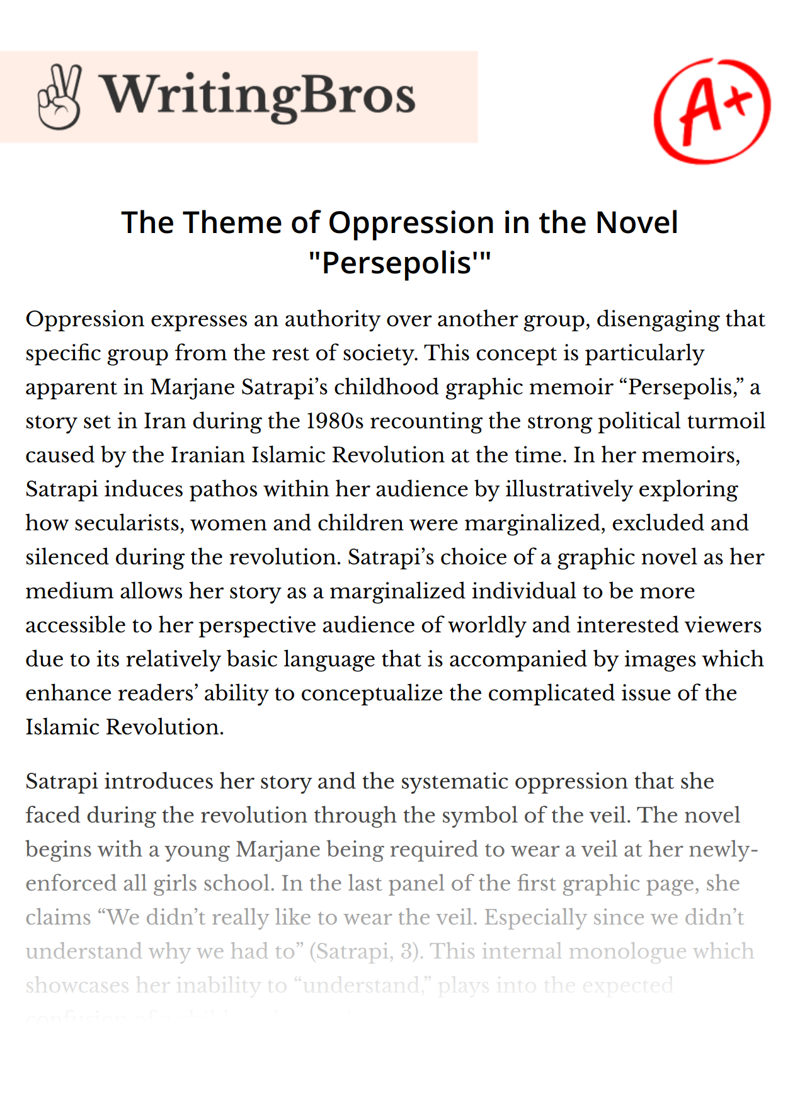The Theme of Oppression in the Novel "Persepolis'"

Oppression expresses an authority over another group, disengaging that specific group from the rest of society. This concept is particularly apparent in Marjane Satrapi’s childhood graphic memoir “Persepolis,” a story set in Iran during the 1980s recounting the strong political turmoil caused by the Iranian Islamic Revolution at the time. In her memoirs, Satrapi induces pathos within her audience by illustratively exploring how secularists, women and children were marginalized, excluded and silenced during the revolution. Satrapi’s choice of a graphic novel as her medium allows her story as a marginalized individual to be more accessible to her perspective audience of worldly and interested viewers due to its relatively basic language that is accompanied by images which enhance readers’ ability to conceptualize the complicated issue of the Islamic Revolution.
Satrapi introduces her story and the systematic oppression that she faced during the revolution through the symbol of the veil. The novel begins with a young Marjane being required to wear a veil at her newly-enforced all girls school. In the last panel of the first graphic page, she claims “We didn’t really like to wear the veil. Especially since we didn’t understand why we had to” (Satrapi, 3). This internal monologue which showcases her inability to “understand,” plays into the expected confusion of a child, and appeals to pathos by stirring emotions of sympathy in the audience whom instantly recognizes the oppressive significance in forcefully having to wear the veil. Through this incident, the introduction of her story portrays that because she is a child and a female living during a takeover by a patriarchal, fundamentalist religious government, Marjane’s voice is among the most marginalized. This makes Satrapi’s accounts of oppression placed on herself and others all the more credible as she is an silenced individual herself. As Marjane recounts how martyrs were acknowledged at school, she writes “They lined us up twice a day to mourn the war dead” (Satrapi, 95). The image illustrates all her peers in veils, signifying the veil to be a common motif throughout the novel. The girls’ facial expressions vary from fear to confusion to anger, but never content. Marjane has no obvious distinction from her classmates, and with this image, Satrapi creates a sense of a loss of individuality, forced conformity, and resignation to oppression. The uniformity of the image and its placement shortly after the forced imposition of the veil paints the veil as a visual symbol of political oppression on women.
Following this event, as the novel continues through the scope of Marjane, she begins to showcase how a multitude of beliefs and actions were silenced and punished during the Islamic Revolution, particularly those held and committed by her family. The chapter “The Wine” observes how Marjane’s secularist family opposes many ideals held by then-current government by illustrating her parents celebrating the birth of her cousin in the first frame of page 105. The panel shows her whole family dancing. Everyone is illustrated in black, except for her father who stands center drawn in white. Her father, as the head of her westernized family, represents the leadership in their beliefs. Therefore, the specific emphasis on her father during this forbidden party is done to showcase his contradiction towards the ideals of the Islamic Regime. During this chapter, her family also experiences a home raid by guards patrolling the streets. Marjane’s father commands her and her grandmother “to flush all the alcohol down the toilets” (Satrapi, 110) which they do so frantically. Their upkeep of alcohol, partying and reading demonstrate the opposition of the Satrapi family’s beliefs with the regime. Furthermore, the panels in “The Wine” that illustrate her family have multiple light tones that indicate openness, while the panels illustrating the guards are dark and closed, indicating a heavy, negative power associated with the authoritative figures in the Islamic Revolution. Satrapi includes this contrast between characters to emphasize the difference between her neutral secularist family, and the fundamentalist, oppressive authorities during the regime.
Within the novel, Satrapi ensures an understanding from her audience about how multiple groups, other than Marjane and her family, were marginalized in Iran during the 1980s. Marjane recounts a story where her family’s maid, Mehri, was subjected to marginalization when “she fell in with the neighbour’s son” (Satrapi, 35). The son is shown to lose interest in Mehri when he finds out she is a maid. Marjane instantly recognizes that the difference in social class is what deemed Mehri insignificant in the eyes of her love interest. Social class also affected others throughout the novel, such as the young boys recruited to the military to fight Iraq. Satrapi’s maid Nassrine’s son was offered a golden key, and was told that with this key he would go to heaven -- if he joined the war. Marjane exclaims that “The key to paradise was for poor people” and that “thousands of young kids, promised a better life, exploded on the minefields with their keys around their neck” (Satrapi, 102). The golden key, symbolizes the key to heaven but also the falseness of government promises, it represents the oppressive and sly existence created post-revolution. The illustration of children dying on minefields is raggedly drawn, and has a sense of loss and instability, emphasizing Marjane’s feelings toward the death of these fellow children, while simultaneously inducing feelings of sympathy and sorrow within the audience.
Throughout Persepolis, the lense of Marjane’s childhood provides the audience with a realistic portrayal of the treatment of certain social groups as it comes perspective of a marginalized person. The black and white imagery included create a concrete visibility for Satrapi’s experiences in a way that few other literary genres would be able to achieve. Through the graphic style of the book, the audience is exposed to how secularists, women, and children, were marginalized, excluded and silenced during the Iranian revolution and regime.
Cite this Essay
To export a reference to this article please select a referencing style below

